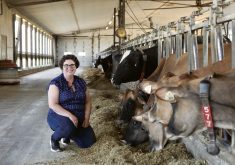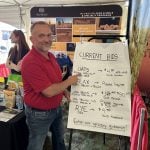Branding that identifies you as the producer and connects buyers to your farm product is a key strategy for adding value to farm products, says Halifax-based business consultant Gary Morton with Morton Horticultural Associates.
“You are kind of in a sea of sameness,” says Morton, who has worked with all types of farms, not only vegetable and fruit producers, helping individual farm businesses develop value-added products and build brands for what they produce.
Morton has followed clients from the idea stage right through to commercial product selling in both domestic and export markets, and he sees more farms making the jump into value-added production.
Read Also

Riding the tariff rollercoaster
Farmers are accustomed to roller-coaster years. But the current geopolitical windstorm is something else entirely. On his cattle operation near…
Value-added production needs a very different management approach with distinct management skill sets, Morton says. “It’s a mind shift. You have to educate consumers and you have to promote that product. Just getting it on to the shelf isn’t promoting it.”
Morton says he’ll stress to anyone considering a value-added venture that before you invest in it, crunch the numbers. And this means doing plenty of groundwork in advance to know if your intended customers perceive value in what you want them to buy.
“The only opinion that really matters when you’re value adding is the person’s who is going to give you money for that product,” Morton says.
“It’s very easy to get caught up in the hype of the whole thing. You can say ‘I like the product. It’s interesting.’ Therefore everyone should like it.”

Ahead of time, Morton says it’s essential to ask, is there enough demand, who will want what you’re going to produce, will they pay, do they have access to it and who’ll distribute it?
“These are all key questions when you’re starting to look at this. The best way to do this is from the point of view of what does the customer need and how am I going to fulfill that need?”
Where failures happen is when people skip asking those questions and charge ahead. They may invest in processing equipment, or build up volume. All too often that’s motivated by concern someone is going to steal your idea or seize the opportunity ahead of you.
The bad news arrives when it’s time to market what you’ve produced, so he sees a need for more resources to support entrepreneurs in that area.
Ironically, getting financing for marketing is also a very tough sell with lenders, Morton says. “But you have to market the product and you have to spend money to do that.”
How big is value added?
On-farm value-added processing is as varied and vast as agriculture itself — from canola crushing, meat packing and dairy processing, to tiny small-scale ventures producing specialty artisanal breads.
It’s a growth sector, but Martin Gooch, chief executive officer with the Ontario-based Value Chain Management International, believes we need to broaden the definition because for primary producers, value adding is really about improving margins and capturing more value from whatever they may be producing.
“‘Capturing value’ is maybe a better term than value added,” Gooch says. “Value added is both about capturing ways of increasing revenue but also reducing costs. The value is both about the cost of producing something and the revenue producing it. Either way the purpose is to benefit financially.”
Gooch also thinks more farmers can benefit from being more direct participants in the value chains they engage with.
Today, a rough estimate says 10 per cent of all farmers proactively participate in value chains. Those who succeed, Gooch says, are focused on what consumers and customers value. They are producing the right product consistently, have developed effective logistics and distribution systems, and effectively communicate and inform.
“It’s how they seek to manage their operations in relation to the value chain in which they operate that differentiates those farmers who are able to add value by working with their customers and suppliers to improve the efficiency of operations within and between firms, and the effectiveness of creating value for the end-consumer,” Gooch says.
Gooch said he does think the category of value added needs broadening.
“We put too narrow a definition on it,” he says. “A farmer going to a weekend farmers’ market could be considered value added and, for individual farmers, it is,” he said.
That’s direct marketing activity, but it does not seem to be an especially high focus of activity by Canadian agricultural producers.
The 2016 Census of Agriculture reported just 13 per cent of farms sell directly to consumers, suggesting the vast majority continue to sell through intermediaries in supply or value chains.
The census also asked what share were selling value-added products as opposed to unprocessed raw commodities. About 14.4 per cent.















